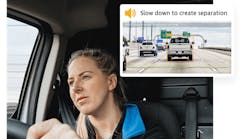Over the years, autonomous truck technology providers have been asked a question repeatedly: How will driverless vehicles handle roadside inspections?
Now, the Commercial Vehicle Safety Alliance (CVSA)—partnering with autonomous trucking providers such as Embark, Kodiak, Locomation, Torc Robotics, TuSimple, Plus, Waymo, among others—believes it has a solution.
During its annual conference and exhibition in Rapid City, South Dakota, in September, CVSA's board of directors approved the launch of a new Enhanced Commercial Motor Vehicle Inspection Program, a procedure standard designed to govern commercial motor vehicle inspections with automated driving systems (ADS).
See also: Embark tests how autonomous trucks will respond to being pulled over
For driver-operated CMVs, a driver conducts a pre-trip inspection before starting a trip and a post-trip inspection at the end of the trip. Along the driver's route, the driver may be required to drive through a weigh/inspection station and/or be stopped on the roadside and may be subject to a standard inspection. However, roadside inspection/weigh station environments present a navigational challenge for autonomous trucks and are incompatible with today's roadside enforcement inspections, which rely on help from drivers.
The announcement of CVSA's new program is the culmination of commercial motor vehicle inspectors and state highway patrols, inspection and enforcement experts, motor carrier representatives, autonomous trucking developers, and federal and state government officials collaborating to develop inspection standards specific to the unique needs, requirements, and challenges of fully autonomous vehicles.
"This has been a long time coming, with Embark and the rest of the AV industry working with CVSA to release the enhanced motor vehicle inspection and safety training course," Alex Rodrigues, CEO and co-founder of Embark, said during the recent Move America conference in Austin, Texas.
See also: Kodiak, Werner Enterprises collaborate to run autonomous long-haul freight
CVSA's new initiative establishes a no-defect, point-of-origin inspection program for ADS-equipped CMVs. It also includes a 40-hour CVSA training course and exam for those conducting the inspections.
"This will be interesting because we'll start to see a much wider group of people becoming certified to perform these inspections," Rodrigues added. "Instead of randomly inspecting trucks, the program will inspect trucks consistently—at least once every 24 hours. We think this will improve the overall inspection regime and timeliness of the inspections."
For the new program, rather than a driver conducting a pre-trip inspection, CVSA-trained motor carrier personnel would conduct the enhanced CMV inspection procedure on selected ADS-equipped vehicles from their fleets at the point of origin before dispatch, as well as in-transit inspections at a dictated interval throughout the trip. Once on the road, the autonomous vehicle would be required to communicate to law enforcement while in motion that it passed the origin/destination inspection, its automated driving systems (as a whole) are functioning, and it is running within its operational design domain. Those autonomous trucks will then bypass fixed inspection sites.
See also: Autonomous, electric, and the 'truck of the future'
According to CVSA, en-route roadside inspections of ADS vehicles by law enforcement officials would be limited to situations where an imminent hazard is observed or during a post-crash investigation. In addition, all autonomous vehicles must be able to respond to law enforcement should an officer attempt to pull over a vehicle, CVSA noted. Any truck or trailer that fails the enhanced inspection procedure at the point of dispatch must be repaired, the agency added.
"ATA was pleased to work with CVSA, our automated truck suppliers, and industry partners in developing an enhanced inspection policy for driverless commercial vehicles," Kevin Grove, director of safety and technology policy for American Trucking Associations, said in a press release. "This is an important step that will facilitate safe and effective deployment of automation."
Embark's Rodrigues said the next step is for autonomous truck technology providers to begin working with partners on AV maintenance and inspections and to begin transmitting data to enforcement agencies.
This article originally appeared on FleetOwner.com.




